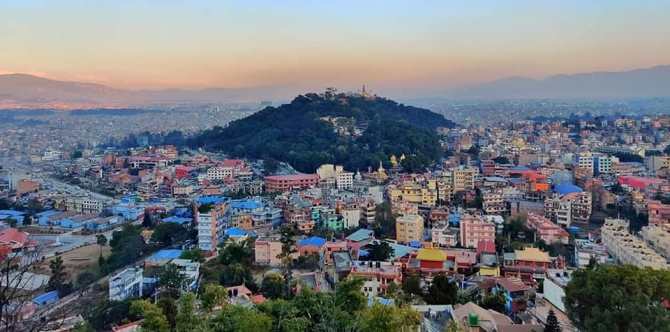Focus on minimising flood havoc in valley: Experts

By Nayak Paudel,
Kathmandu, July 24: Every year when the rainy season begins, rivers in the Kathmandu Valley wreak havoc as water levels increase and enter the settlements nearby, destroying property and sometimes even leading to human casualty.
The scenario has been the same for decades as the rivers such as Bagmati, Bishnumati, Manohara and Balkhu among others submerge many settlements nearby the river banks in all three districts-- Kathmandu, Bhaktapur and Lalitpur—of the valley.
The rivers stay calm until the arrival of monsoon but once it starts raining on a regular basis, the rivers become furious because the rivers’ area has been encroached for creating new settlements.
“The rivers’ areas have been encroached as structures are constructed along the floodplains and banks of the rivers flowing across the valley. When the rainy season starts and the flow and levels of water increase, the river damage the structures constructed in its route,” said Kishore Thapa, an urban planner.
Over the years, concerned authorities have regularly been requesting the locals to abide by the standards before constructing any structure near the river banks. However, new structures kept on adding alongside the river banks every year.
On January 29, 2016, a High Powered Committee for Integrated Development of the Bagmati Civilisation (HPCIDBC) had published a notice in two national dailies requesting locals residing along the area about the structures disallowed by the standards mentioned in the Kathmandu building code.
As per the code, no structure is allowed to be constructed within 20 metres on the either side of the Bagmati, Bishnumati and Manohara rivers. Similarly, required area has been allocated for other rivers such as the Nakkhu, Dhobikhola, Balkhu and Hanumante among others where the floodplains should be left empty for the rivers to flow in an undisturbed manner.
“There are restrictions but construction of structures along the river banks has not been stopped. We have regularly been requesting the locals to clear the areas, but no one listens to us. Moreover, there are people who have no place to go other than the river banks due to which the evacuation has been difficult,” said Lila Prasad Dhakal, acting project manager at HPCIDBC.
The recent rainfall has already terrorised locals living nearby the river banks and over the floodplains as the water has already entered many places. Since the problem is regular, the experts argue that the authorities must focus on minimising the loss every year.
“The structures have already been built and the government does not have the capacity to relocate the people residing there nor to stop the rivers from entering the settlements. Now, the authorities must focus on minimising the losses,” suggested Thapa, who is also a former government secretary.
As per Thapa, the authorities must have an early warning system throughout the day and night and keep a rescue team standby. Similarly, the locals living in the flood-prone areas and those who have been facing damages every year have been suggested to find a place to live during the monsoon season.
“Everyone is the citizen of the country and it is the government’s responsibility to take care of them. The government can rescue people of places with high risk of flood in safe places,” Thapa added. The authorities have also been suggested to maintain the drainage system on a regular basis so that the garbage does not obstruct the water to exit properly.
Meanwhile, the government has disclosed its plans to take necessary steps in preventing the losses and provide relief to the victims at the earliest. Issuing a press statement on Wednesday, the Ministry of Home Affairs have stated that it has directed all the Chief District Officers and District Disaster Management Committees to keep ready 25 individuals each for rescue mission during the disaster.
Similarly, the ministry has also revealed to provide relief materials and compensation to the victims at the earliest. “As the settlements have already been rampant along the river banks, the best way for the authorities is to prepare in a way that they can minimise the damage from floods in the rainy season,” said Dhakal.
Recent News

Do not make expressions casting dout on election: EC
14 Apr, 2022
CM Bhatta says may New Year 2079 BS inspire positive thinking
14 Apr, 2022
Three new cases, 44 recoveries in 24 hours
14 Apr, 2022
689 climbers of 84 teams so far acquire permits for climbing various peaks this spring season
14 Apr, 2022
How the rising cost of living crisis is impacting Nepal
14 Apr, 2022
US military confirms an interstellar meteor collided with Earth
14 Apr, 2022
Valneva Covid vaccine approved for use in UK
14 Apr, 2022
Chair Prachanda highlights need of unity among Maoist, Communist forces
14 Apr, 2022
Ranbir Kapoor and Alia Bhatt: Bollywood toasts star couple on wedding
14 Apr, 2022
President Bhandari confers decorations (Photo Feature)
14 Apr, 2022











